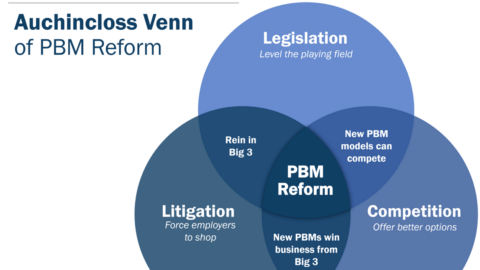I’m pretty sure Cost Curve will be off tomorrow. Friday will be a coin flip.
If you want to search Cost Curve back issues or link to anything you read here, the web links and archive are online at costcurve.beehiiv.com. You can subscribe there, too.
I struggle with putting 340B in context, dollar-wise. It has grown to an enormous size, but it’s hard to explain exactly how “enormous” is “enormous” is. It’s often pointed out that 340B is larger than the Medicaid drug program. More colorfully, the size of 340B exceeds the revenue of all of the major professional sports.
But that’s still somehow lacking.
So here’s another way of looking at it: What if the profits from 340B, rather than being routed opaquely, to hospital bottom lines, were instead used to retire medical debt? How big an impact could that have?
Doing the math** from a conservative estimate of 340B profits ($50 billion), using 340B profits to retire debt would — poof — put more than 17 million people back in the black. That’s more than 85% of all those with medical debt. And that’s just one year!
I know I’m being a little cute with the concept here. It’s not like all medical debt is held by 340B hospitals or that the 340B profits exist as a pot of money that can be directed in this way. This is more thought experiment than policy proposal.
Still: from a 30,000-foot view, it puts things into perspective. Is the 340B program creating as much good as eliminating the medical debt of 17 million people?
And if the answer is “no,” don’t we have some sort of obligation to think about ways to reform the 340B program to make sure that it’s having more impact?
** Happy to pass along the calculations for those interested.
I wrote yesterday about the way Antonio Ciaccia of 46brooklyn/3 Axis Advisors fame was being targeted in a shadowy campaign, all based around a low-quality** hit piece in the Washington Examiner.
The scandal here is not that the Washington Examiner wrote something. That’s an easy publication to ignore. The scandal is who placed the story, and who is trying like h*ck to amplify it.
On the second question, we’re getting more hints. Yesterday, Conservatives for Lower Health Care Costs blasted out an email drawing attention to the Examiner story, suggesting that Antonio is behind an “assault on free market forces.”
Who are “Conservatives for Lower Health Care Costs”? Naturally, their website doesn’t say. But the last time these guys made noise, Twitter users did some detective work, finding an older version of the webpage that made clear that communications from CFLHCC were coming from PCMA, the PBM lobby.
Again, if you want to take on Antonio on the merits, I’m here for it. My DMs are open.
But to go after him with a weird front group that tries to co-opt conservative tropes (CFLHCC’s site has a scowling picture of Bernie Sanders and uses the phrase “socialist” six times) is intellectually dishonest.
This is a group that represents some of the biggest companies in the history of the planet Earth. They’re going after a guy who is genuine in his desire to shine a light in the darker corners of drug supply chain.
And that includes pharma pricing! There is no single person who has done more to elevate the conversation about list-price increases than Antonio. And he’s doing that work for free, pushing out reports every month, often to my dismay. Not exactly the work of someone who is compromised.
Last night, I received some advice from a PBM skeptic for whom I have a lot of respect: let this lie. Drawing attention to the issue just keeps this on the radar.
I’m not sure that’s right.
We’re seeing the corporate equivalent of cyber-bullying here, layering in assaults on the press and appeals to institutional distrust, all fomented by economically dominant corporations. That’s not a remotely healthy way to get the health system we all want.
My hope is that people who tune into this brouhaha will come away with a greater appreciation for Antonio’s work and a deep skepticism for any PBM arguments that don’t have data attached.
This is a conversation that deserves better.
** What makes it low quality? In general, if you want to accuse someone of bias, you comb through their work and find places where that bias peeks through. But the Examiner story doesn’t even bother with that. Antonio’s work here goes back years, and there’s a ton of it to paw through. The fact that the report didn’t find anything suspect — or didn’t bother looking — suggests laziness, a lack of familiarity with the subject, or an axe to grind. None of those are good looks.
USC just published an important white paper that grapples with the literature around the “elasticity” of innovation — the degree of change in innovation prompted by changes in revenue — when it comes to biopharma. The conclusion: for every 10% decline in revenue, there’s a 2.5% to 15% drop in innovation (trial starts, new medicines, etc.) The details here are not easy sledding, but the work is sound. This is critical stuff for those making arguments about the impact of polices such as the IRA.
PhRMA released its 2025 policy priorities, leaning into IP, price controls, 340B, and PBM reform. It didn’t escape my notice that all of those priorities intersect with the topic of drug pricing, so I expect this will be a fun year. (I mean, that’s already pretty evident, but …)
Speaking of PhRMA and their priorities, there’s more coverage on intersections between the industry and the new administration, with Bloomberg reporting on a meeting scheduled for tomorrow between top execs and Donald Trump. The piece also has details on how the industry is thinking about the next four years, based the PhRMA Forum gathering yesterday.
It’s not news that I’m a fan of Rep. Jake Auchincloss’ thinking on PBM reform, so I was thrilled to see him interviewed by Erza Klein so that he could explore some of his thinking in depth. The PBM bits are scattered through a larger conversation on TikTok, zoning laws, and the like, but the whole thing is worth the read.
The biosimilars market is just wild. It really seems like the key to surviving at this point is partnering with a PBM subsidiary to white-label your biosim and guarantee volume. Case in point is an announcement from Formycon that it expects to have to take a charge of around $100 million on its Stelara biosimilar because of “an emerging, significantly higher-than-expected price discount for biosimilars in the U.S.”
You go, Mel! Fierce has a nice profile of Mel Whittingham’s effort to build out a library of cost-effectiveness analyses as part of her leadership of the Leerink Center for Pharmacoeconomics.
Cost Curve is produced by Reid Strategic, a consultancy that helps companies and organizations in life sciences communicate more clearly and more loudly about issues of value, access, and pricing. We offer a range of services, from strategic planning to tactical execution, designed to shatter the complexity that hampers constructive conversations.
To learn more about how Reid Strategic can help you, email Brian Reid at brian@reidstrategic.com.





